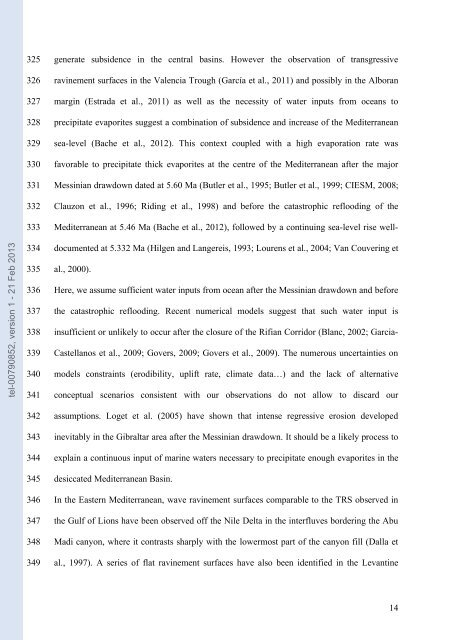Quantification des flux sédimentaires et de la subsidence du bassin ...
Quantification des flux sédimentaires et de la subsidence du bassin ...
Quantification des flux sédimentaires et de la subsidence du bassin ...
You also want an ePaper? Increase the reach of your titles
YUMPU automatically turns print PDFs into web optimized ePapers that Google loves.
tel-00790852, version 1 - 21 Feb 2013<br />
325<br />
326<br />
327<br />
328<br />
329<br />
330<br />
331<br />
332<br />
333<br />
334<br />
335<br />
336<br />
337<br />
338<br />
339<br />
340<br />
341<br />
342<br />
343<br />
344<br />
345<br />
346<br />
347<br />
348<br />
349<br />
generate subsi<strong>de</strong>nce in the central basins. However the observation of transgressive<br />
ravinement surfaces in the Valencia Trough (García <strong>et</strong> al., 2011) and possibly in the Alboran<br />
margin (Estrada <strong>et</strong> al., 2011) as well as the necessity of water inputs from oceans to<br />
precipitate evaporites suggest a combination of subsi<strong>de</strong>nce and increase of the Mediterranean<br />
sea-level (Bache <strong>et</strong> al., 2012). This context coupled with a high evaporation rate was<br />
favorable to precipitate thick evaporites at the centre of the Mediterranean after the major<br />
Messinian drawdown dated at 5.60 Ma (Butler <strong>et</strong> al., 1995; Butler <strong>et</strong> al., 1999; CIESM, 2008;<br />
C<strong>la</strong>uzon <strong>et</strong> al., 1996; Riding <strong>et</strong> al., 1998) and before the catastrophic reflooding of the<br />
Mediterranean at 5.46 Ma (Bache <strong>et</strong> al., 2012), followed by a continuing sea-level rise well-<br />
documented at 5.332 Ma (Hilgen and Langereis, 1993; Lourens <strong>et</strong> al., 2004; Van Couvering <strong>et</strong><br />
al., 2000).<br />
Here, we assume sufficient water inputs from ocean after the Messinian drawdown and before<br />
the catastrophic reflooding. Recent numerical mo<strong>de</strong>ls suggest that such water input is<br />
insufficient or unlikely to occur after the closure of the Rifian Corridor (B<strong>la</strong>nc, 2002; Garcia-<br />
Castel<strong>la</strong>nos <strong>et</strong> al., 2009; Govers, 2009; Govers <strong>et</strong> al., 2009). The numerous uncertainties on<br />
mo<strong>de</strong>ls constraints (erodibility, uplift rate, climate data…) and the <strong>la</strong>ck of alternative<br />
conceptual scenarios consistent with our observations do not allow to discard our<br />
assumptions. Log<strong>et</strong> <strong>et</strong> al. (2005) have shown that intense regressive erosion <strong>de</strong>veloped<br />
inevitably in the Gibraltar area after the Messinian drawdown. It should be a likely process to<br />
exp<strong>la</strong>in a continuous input of marine waters necessary to precipitate enough evaporites in the<br />
<strong><strong>de</strong>s</strong>iccated Mediterranean Basin.<br />
In the Eastern Mediterranean, wave ravinement surfaces comparable to the TRS observed in<br />
the Gulf of Lions have been observed off the Nile Delta in the interfluves bor<strong>de</strong>ring the Abu<br />
Madi canyon, where it contrasts sharply with the lowermost part of the canyon fill (Dal<strong>la</strong> <strong>et</strong><br />
al., 1997). A series of f<strong>la</strong>t ravinement surfaces have also been i<strong>de</strong>ntified in the Levantine<br />
14

















